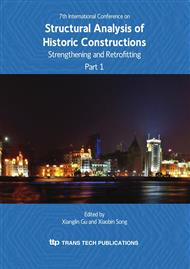[1]
Beolchini, G C, Milano, L, and Antonacci, E (editors) (2005).
Google Scholar
[2]
Binda, L, Cardani, G, Saisi, A, Valluzzi, M R, Munari, M, and Modena, C (2007).
Google Scholar
[3]
Consiglio Superiore Lavori Pubblici (Italian Public Works Council) and MiBAC (2006). Linee guida per la valutazione e riduzione del rischio sismico del patrimonio culturale.
Google Scholar
[4]
D'Ayala, D, and Speranza, E (2003). Definition of collapse mechanisms and seismic vulnerability of Historic Masonry Buildings., Earthquake Spectra, 19(3), 479-509.
DOI: 10.1193/1.1599896
Google Scholar
[5]
Doglioni, F, Moretti, A, and Petrini, V (1994). Le chiese e il terremoto, edizioni LINT, Trieste.
Google Scholar
[6]
Giuffrè, A (1995). Letture sulla meccanica delle murature storiche, Roma, Kappa.
Google Scholar
[7]
Lagomarsino, S, and Podestà, S (2004a). Seismic vulnerability of ancient churches: part 1. Damage assessment and emergency planning., Earthquake Spectra, 20(2), 377-394.
DOI: 10.1193/1.1737735
Google Scholar
[8]
Lagomarsino, S, and Podestà, S (2004b). Seismic vulnerability of ancient churches: part 2. statistical analysis of sureveyed data and methods for risk analysis., Earthquake Spectra, 20(2), 395-412.
DOI: 10.1193/1.1737736
Google Scholar
[9]
Lagomarsino, S, and Podestà, S (2004c). Damage and vulnerability assessment of churches after the 2002, Molise, Italy earthquake., Earthquake Spectra, 20(S1), S271-283.
DOI: 10.1193/1.1767161
Google Scholar
[10]
MiBAC (2009). Briefing of the L'Aquila Delegate for Cultural Heritage, " Struttura del Vice Commissario delegato per la salvaguardia dei beni culturali, October 25, L, Aquila.
Google Scholar
[11]
Modena, C, Valluzzi, M R, and Zenere, M (2004). c-Sisma 2. 0, Procedura automatica per il calcolo del coefficiente sismico di collasso di pareti in muratura, University of Padova.
Google Scholar
[12]
Neumair, S, Casolo, S, Parisi, M. A, Petrini, V (2000). A simplified analysis of seismic damage patterns in old masonry church facades., Earthquake Spectra, 16(4), 757-774.
DOI: 10.1193/1.1586138
Google Scholar
[13]
PCM-DPC, MiBAC (2006a). Scheda per il rilievo del danno ai beni culturali - Chiese, Italian Ministry of Cultural Heritage.
Google Scholar
[14]
PCM-DPC, MiBAC (2006b). Scheda per il rilievo del danno ai beni culturali - Palazzi, Italian Ministry of Cultural Heritage.
Google Scholar
[15]
Valluzzi, M . R, Munari, M, Modena, C., Binda, L, Cardani, G, and Saisi, A (2007).
Google Scholar


